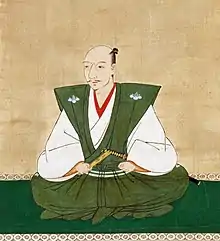Oda Nobunaga
Oda Nobunaga (織田 信長, ![]() listen; 23 June 1534 – 21 June 1582) was a Japanese daimyō and one of the leading figures of the Sengoku period. He is regarded as the first "Great Unifier" of Japan.
listen; 23 June 1534 – 21 June 1582) was a Japanese daimyō and one of the leading figures of the Sengoku period. He is regarded as the first "Great Unifier" of Japan.
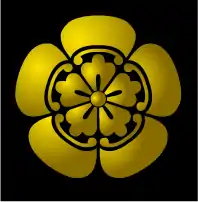
Nobunaga was head of the powerful Oda clan, and launched a war against other daimyo's to unify Japan in the 1560s. Nobunaga emerged as the most powerful daimyō in Japan, overthrowing the nominally ruling shōgun Ashikaga Yoshiaki and dissolving the Ashikaga Shogunate in 1573. He then conquered most of Honshu, and defeated the Ikkō-ikki rebels by the 1580s. Nobunaga's rule was noted for innovative military tactics, fostering free trade, reform of Japan's civil government, and encouraging the start of the Momoyama historical art period, but also for the brutal suppression of opponents, eliminating those who refused to cooperate or yield to his demands. Nobunaga was killed in the Honno-ji Incident in 1582 when his retainer Akechi Mitsuhide ambushed him in Kyoto and forced him to commit sepuku. Nobunaga was succeeded by Toyotomi Hideyoshi who along with Tokugawa Ieyasu completed his war of unification shortly afterwards.
Nobunaga was an influential figure in Japanese history and is regarded as one of three great unifiers along with his retainers Toyotomi Hideyoshi and Tokugawa Ieyasu. Toyotomi Hideyoshi would later unite Japan in 1591, and invade Korea a year later. However, in 1598 he died and Tokugawa Ieyasu took power after the Battle of Sekigahara in 1600, becoming shogun in 1603, and ending the Sengoku period.
Early life (1534–1551)

Oda Nobunaga was born on June 23, 1534 in Nagoya, Owari Province, and was the second son of Oda Nobuhide, the head of the powerful Oda clan and a deputy shugo (military governor), and his wife Dota Gozen.[1] Nobunaga is said to have been born in Nagoya Castle, the future seat of the Owari Domain, although this is subject to debate. Nobunaga was given the childhood name of Kippōshi (吉法師), and through his childhood and early teenage years became well known for his bizarre behavior, receiving the name of Owari no Ōutsuke (尾張の大うつけ, The Fool of Owari).[1] Nobunaga was a clear speaker with a strong presence about him, and known to run around with other youths from the area, without any regard to his own rank in society, and with the introduction of firearms into Japan he became known for his fondness for tanegashima guns.
Unification of Owari (1551–1560)

Succession crisis
In 1551, Oda Nobuhide died unexpectedly. Oda Nobuhiro, Nobuhide's eldest son, became the new head of the Oda clan. It has been said that Nobunaga acted outrageously during his funeral, throwing ceremonial incense at the altar.[2] Although Nobunaga was Nobuhide's legitimate heir, a succession crisis occurred when some of the Oda clan were divided against him. Hirate Masahide, a valuable mentor and retainer to Nobunaga, performed seppuku to startle Nobunaga into his obligations.[3]:68 Nobunaga, collecting about a thousand men, suppressed members of his family who were hostile to his rule and their allies.
Sometime later in 1551, an Imagawa army under the command of Imagawa Sessai laid siege to the Anjō castle where Oda Nobuhiro was living. Nobuhiro was trapped by the Imagawa clan, but was saved when Nobunaga handed over one of his hostages at Honshōji temple, nine years old "Matsudaira Takechiyo" – later known as Tokugawa Ieyasu – to make up for not lifting the siege of Anjō. Afterwards, Nobuhiro was forced to step down and allow Nobunaga to be the new head of the Oda clan. Later on, Nobuhiro plotted against Nobunaga with the assistance of Saitō Yoshitatsu, but Nobunaga forgave Nobuhiro after the plot failed.
Consolidation of clan leadership
In 1553, Nobuhide's younger brother, Oda Nobutomo, took over Kiyosu Castle with the support of Shiba Yoshimune. After Yoshimune revealed to Nobunaga an assassination plot in 1554, Nobutomo had Yoshimune put to death. The next year, Nobunaga re-took Kiyosu Castle and captured his uncle, forcing him to commit suicide.
Nobunaga's main rival as head of the Oda clan was his younger brother, Oda Nobuyuki. In 1555, Nobunaga defeated Nobuyuki at the Battle of Ino, though Nobuyuki survived and began plotting a second rebellion. In 1556, Nobunaga destroyed and razed a rival branch of the Oda clan located in Kiyosu Castle.[4]:276 At the same time, Nobunaga sent an army to Mino Province to aid his father-in-law, Saitō Dōsan, after Dōsan's son, Saitō Yoshitatsu, turned against him. The campaign failed, as Dōsan was killed in the Battle of Nagara-gawa, and Yoshitatsu became the new master of Mino.[3] In 1557, Nobuyuki was defeated by Nobunaga's retainer Ikeda Nobuteru. Nobunaga killed Nobuyuki at Kiyosu Castle and destroyed Suemori Castle.[3]:69
In 1558, Nobunaga sent an army to protect Suzuki Shigeteru in the Siege of Terabe.[3] Shigeteru had defected to Nobunaga's side from Imagawa Yoshimoto, a daimyō from Suruga Province, one of the most powerful men in the Tōkaidō region. By 1559, Nobunaga had captured and obliterated the fortress of Iwakura, eliminated all opposition within the Oda clan and established his uncontested rule in Owari Province.[4]:276
Rise to Power (1560–1568)

Conflict with Imagawa
Imagawa Yoshimoto was a long-time opponent of Nobunaga's father, and had sought to expand his domain into Oda territory in Owari. In 1560, Imagawa Yoshimoto gathered an army of 25,000 men,[5]and started his march toward the capital city of Kyoto, with the pretext of aiding the frail Ashikaga Shogunate. The Matsudaira clan also joined Yoshimoto's forces, and Sieged Marune Fortress. Against this, the Oda clan could rally an army of only 2,000 to 3,000 men.[6][7] Some of his advisors suggested "to stand a siege at Kiyosu" but Nobunaga refused, stating that "only a strong offensive policy could make up for the superior numbers of the enemy", and calmly ordered a counterattack against Yoshimoto.[4]
Battle of Okehazama
In June 1560, Nobunaga's scouts reported that Yoshimoto was resting at the narrow gorge of Dengaku-hazama, ideal for a surprise attack, and that the Imagawa army was celebrating their victories of Washizu and Marune fortress. While Yoshimoto viewed victory ahead, Nobunaga’s forces soon arrived at the Zensho-ji, a fortified temple overlooking the Imagawa forces camp site. Nobunaga ordered his men to set up an array of flags and dummy troops made of straw and spare helmets around the Zensho-ji, giving the impression of a large host, while the real Oda army hurried round in a rapid march to get behind Yoshimoto's camp. The heat gave way to a terrific thunderstorm, and as the Imagawa samurai sheltered from the rain, Nobunaga deployed his troops at Kamagatani. When the storm ceased, they charged down upon the enemy. At first, Yoshimoto thought a brawl had broken out among his men, but then he realized that it was an attack when two of Nobunaga's samurais, Mōri Shinsuke and Hattori Koheita, charged up at him. One aimed a spear at him, which Yoshimoto deflected with his sword, but the second swung his blade and decapitated him.[8][9] With his victory in this battle, Oda Nobunaga gained greatly in prestige, and many samurai and warlords pledged fealty to him.
This battle would also be the first time Nobunaga noticed the talents of the sandal-bearer, "Kinoshita Tōkichirō" who would eventually become Toyotomi Hideyoshi.
Alliance with Matsudaira (later Tokugawa) and Takeda
Rapidly weakening in the wake of this battle, the Imagawa clan no longer exerted control over the Matsudaira clan. In 1561, an alliance was forged between Oda Nobunaga and Matsudaira Motoyasu (who would become Tokugawa Ieyasu), despite the decades-old hostility between the two clans. Nobunaga also formed an alliance with Takeda Shingen through the marriage of his daughter to Shingen's son.[4]:277–78[10]
Mino campaign
In 1561, Saitō Yoshitatsu, an enemy of the Oda clan, died suddenly of illness and was succeeded by his son, Saitō Tatsuoki. However, Tatsuoki was young and much less effective as a ruler and military strategist compared to his father and grandfather.[6]:57 Taking advantage of this situation, Nobunaga moved his base to Komaki Castle and started his campaign in Mino, and defeated Tatsuoki in both the Battle of Moribe[3]:216 and the Battle of Jushijo in June that same year.
By convincing Saitō retainers to abandon their incompetent and foolish master, Nobunaga significantly weakened the Saitō clan. In 1564, Oda Nobunaga dispatched his retainer, Kinoshita Tōkichirō, to bribe many of the warlords in the Mino area to support the Oda clan.
In 1566, Nobunaga charged Kinoshita to build Sunomata Castle on the bank of the Sai River opposite Saitō territory, to serve as a staging point for the Oda forces, and to intimidate, surprise and demoralize the enemy. In 1567, Inaba Ittetsu along with Andō Michitari and Ujiie Bokuzen, agreed to join the forces of Oda Nobunaga. Eventually, they mounted a victorious final attack at the Siege of Inabayama Castle.[4]:278 After taking possession of the castle, Nobunaga changed the name of both Inabayama Castle and the surrounding town to Gifu. Nobunaga derived the term Gifu from the legendary Mount Qi (岐山 Qi in Standard Chinese) in China, on which the Zhou dynasty is fabled to have started. Nobunaga revealed his ambition to conquer the whole of Japan, and also started using a new personal seal that read Tenka Fubu (天下布武), which means "All the world by force of arms" or "Rule the Empire by Force".[11][4]:278 Remains of Nobunaga's residence in Gifu can be found today in Gifu Park.[12]
Omi campaign and march to Kyoto
Following Nobunaga's conquest of Mino in 1567, in an effort to cement an alliance between Nobunaga and rival warlord Azai Nagamasa from Omi Province, Nobunaga arranged for Oichi, his sister, to marry Nagamasa. Nobunaga desired peaceful relations with the Azai clan because of their strategic position in between the Oda clan's land and the capital, Kyoto.
In 1568, Ashikaga Yoshiaki and Akechi Mitsuhide, as Yoshiaki's bodyguard, went to Gifu to ask Nobunaga to start a campaign toward Kyoto. Yoshiaki was the brother of the murdered 13th shōgun of the Ashikaga Shogunate, Yoshiteru, and wanted revenge against the killers who had already set up a puppet shōgun, Ashikaga Yoshihide. Nobunaga agreed to install Yoshiaki as the new shōgun and, grasping the opportunity to enter Kyoto, started his campaign. An obstacle in southern Ōmi Province was the Rokkaku clan, led by Rokkaku Yoshikata, who refused to recognize Yoshiaki as shōgun and was ready to go to war to defend Yoshihide. In response, Nobunaga launched a rapid attack of Chōkō-ji Castle, driving the Rokkaku clan out of their castles.[4]:278–79 Other forces led by Niwa Nagahide defeated the Rokkaku on the battlefield and entered Kannonji Castle, before resuming Nobunaga's march to Kyoto. Later in 1570, the Rokkaku tried to re-take the castle, but they were driven back by Oda forces led by Shibata Katsuie. The approaching Oda army influenced the Matsunaga clan to submit to the future Shogun. The daimyo Matsunaga Hisahide kept his title by making this decision to ally his clan with the shogun.
On November 9, 1568, Nobunaga entered Kyoto, drove out the Miyoshi clan, who fled to Settsu, and installed Yoshiaki as the 15th shōgun of the Ashikaga Shogunate. However, Nobunaga refused the title of Shōgun's deputy (Kanrei), or any appointment from Yoshiaki. As their relationship grew difficult, Yoshiaki secretly started an anti-Nobunaga alliance, conspiring with other daimyos to get rid of Nobunaga, though Nobunaga had a great respect with the Emperor Ōgimachi.[13][4]:279–81
Unification of Japan (1568–1582)
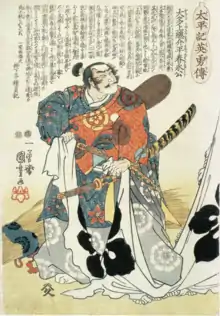
Conflict with Azai and Asakura
After installed Yoshiaki as Shogun, Nobunaga had evidently pressed Yoshiaki to request all the local Daimyô to come to Kyôto and attend a certain banquet. Asakura Yoshikage, head of the Asakura clan was the regent of Ashikaga Yoshiaki, refused, an act Nobunaga declared disloyal to both the shogun and the emperor. With this pretext well in hand, Nobunaga raised an army and marched on Echizen.[4]:281 In early 1570, Nobunaga launched campaign into the Asakura clan's domain and besieged Kanagasaki Castle. Azai Nagamasa, to whom Nobunaga's sister Oichi was married, broke the alliance with the Oda clan to honor the Azai-Asakura alliance, which had lasted for generations. With the help of the Rokkaku clan and the Ikkō-ikki, the anti-Nobunaga alliance sprang into full force, taking a heavy toll on the Oda clan. Nobunaga found himself facing both the Asakura and Azai forces and when defeat looked certain, Nobunaga decided to retreat from Kanagasaki, which went successfully. Later, they clashed at the Battle of Anegawa.
Battle of Anegawa
In July 1570, the Oda-Tokugawa allies marched on Yokoyama and Odani Castles, and the combined Azai-Asakura force marched out to confront Nobunaga. Nobunaga advanced to the southern bank of the Anegawa. The following morning, on July 30, 1570, the battle between the Oda and the Azai-Asakura forces began. Tokugawa Ieyasu joined his forces with Nobunaga, with the Oda and Azai clashing on the right while Tokugawa and Asakura grappled on the left. The battle turned into a melee fought in the middle of the shallow Ane River. For a time, Nobunaga's forces fought the Azai upstream, while the Tokugawa warriors fought the Asakura downstream. After the Tokugawa forces finished off the Asakura, they turned and hit the Azai right flank. The troops of the Mino Triumvirate, who had been held in reserve, then came forward and hit the Azai left flank. Soon both the Oda and Tokugawa forces defeated the combined forces of the Asakura and Azai clans.[4]:282
In 1573, at the Siege of Odani Castle and the Siege of Ichijōdani Castle, Nobunaga successfully destroyed the Asakura and Azai clans by driving them both to the point that the clan leaders committed suicide.[10]:156[4]:281,285–86
Ikkō-ikki campaigns
Nobunaga faced a significant threat from the Ikkō-ikki, a resistance movement centered around the Jōdo Shinshū sect of Buddhism. The Ikkō-ikki began as a religious association for self-defence, but popular antipathy against the samurai from the constant violence of the Sengoku period caused their numbers to swell. By the time of Nobunaga's rise to power, the Ikkō-ikki was a major organized armed force opposed to samurai rule in Japan. In August 1570, the Ishiyama Hongan-ji War begin, Nobunaga campaign against the Ikkō-ikki, while fighting against his samurai rivals. In May 1571, Nobunaga besieged Nagashima, a series of Ikkō-ikki fortifications in Owari Province, beginning the Sieges of Nagashima.
Siege of Mount Hiei
In the meantime, the Enryaku-ji monastery on Mt. Hiei, with its sōhei (warrior monks) of the Tendai school who aided the anti-Nobunaga group by helping the Azai-Asakura alliance, was an issue for Nobunaga since the monastery was so close to his base of power. In September 1571, Nobunaga preemptively attacked the Enryaku-ji monastery, then besieged Mount Hiei and razed it. In the process of making their way to the Enryaku-ji temple, Nobunaga's forces destroyed and burnt all buildings, killing monks, laymen, women, children and eliminating anyone who had previously escaped their attack. it is said "The whole mountainside was a great slaughterhouse and the sight was one of unbearable horror."[4]:284 This action gained him renown as the Demon Daimyo or Devil King.

Siege of Nagashima
Nobunaga's first siege of Nagashima ended in failure, as his trusted general Shibata Katsuie was severely wounded and many of his samurai were lost before retreating. Despite this defeat, Nobunaga was inspired to launch another siege after the success of the Siege of Mount Hiei. In July 1573, Nobunaga besieged Nagashima for a second time, personally leading a sizable force with many arquebusiers. However, a rainstorm rendered his arquebuses inoperable while the Ikkō-ikki's own arquebusiers could fire from covered positions. Nobunaga himself was almost killed and forced to retreat, with the second siege being considered his greatest defeat.
In 1574, Nobunaga launched a third siege of Nagashima as his general Kuki Yoshitaka began a naval blockade and bombardment of Nagashima, allowing him to capture the outer forts of Nakae and Yanagashima as well as part of the Nagashima complex. The Sieges of Nagashima finally ended when Nobunaga's men completely surrounded the complex and set fire to it, killing the remaining tens of thousands of defenders and inflicting tremendous losses to the Ikkō-ikki.[3]:221–25
Siege of Ishiyama Hongan-ji
Simultaneously, Nobunaga had been besieging the Ikkō-ikki's main stronghold at Ishiyama Hongan-ji in present-day Osaka. Nobunaga's Siege of Ishiyama Hongan-ji began to slowly make some progress, but the Mōri clan of the Chūgoku region broke his naval blockade and started sending supplies into the strongly fortified complex by sea. As a result, in 1577, Hashiba Hideyoshi was ordered by Nobunaga to confront the warrior monks at Negoroji, and Nobunaga eventually blocked the Mōri's supply lines.[4]:288–89[3]:228
In 1580, ten years after the siege of Ishiyama Hongan-ji began, the son of Chief Abbot Kōsa surrendered the fortress to Nobunaga after their supplies were exhausted, and they received an official request from the Emperor to do so.[14] Nobunaga spared the lives of Ishiyama Hongan-ji's defenders, but expelled them from Osaka and burnt the fortress to the ground. Although the Ikkō-ikki continued to make a last stand in Kaga Province, Nobunaga's capture of Ishiyama Hongan-ji crippled them as a major militant force.
Conflict with Takeda
One of the strongest rulers in the anti-Nobunaga alliance was Takeda Shingen, who used to be an ally of the Oda clan. At the apex of the anti-Nobunaga coalition, in 1572, Takeda Shingen ordered Akiyama Nobutomo, one of the "Twenty-Four Generals" of Shingen, to attack Iwamura castle. Nobunaga's aunt, Lady Otsuya, conspired against the Oda clan, surrendered the castle to the Takeda and married Nobutomo. From there, the Takeda-Oda relationship declined and Nobunaga started a campaign against the Takeda clan.
In the same year, Shingen decided to make a drive for Kyoto at the urgings of the shōgun Ashikaga Yoshiaki, starting with invading Tokugawa territory. Nobunaga, tied down on the western front, sent lackluster aid to Tokugawa Ieyasu who suffered defeat at the Battle of Mikatagahara in 1573. However, after the battle, Tokugawa's forces launched night raids and convinced Takeda of an imminent counter-attack, thus saving the vulnerable Tokugawa with the bluff. This would play a pivotal role in Tokugawa's philosophy of strategic patience in his campaigns with Nobunaga. Shortly thereafter, the Takeda forces were neutralized after Shingen died in April of 1573.[10]:153–56
End of the Ashikaga Shogunate
After the death of Takeda Shingen, Nobunaga's entry into Kyôto presented him with a situation very different from that from which he had come. He focused on Ashikaga Yoshiaki, who had openly declared hostility more than once, despite the Imperial Court's intervention. Nobunaga was able to defeat Yoshiaki's forces, and the power of the Ashikaga was effectively destroyed on August 27, 1573, when Nobunaga drove Yoshiaki out of Kyoto and sent him into exile. Yoshiaki became a Buddhist monk, shaving his head and taking the name Sho-san, which he later changed to Rei-o In, bringing the Ashikaga Shogunate to an end.
Imperial Court appointments
After the Ashikaga Shogunate came to end, the authority of the Imperial Court of Emperor Ōgimachi also began to fall. This trend reversed after Oda Nobunaga entered Kyoto in a show of allegiance that indicated that the Emperor had the Oda clan's support.
In early 1574, Nobunaga was promoted to the Lower Third Rank (Ju Sanmi) of the Imperial Court and made a Court Advisor (Sangi). Court appointments would continue to be lavished on a nearly annual basis, possibly in hope of placating him. Nobunaga acquired many official titles, including Major Counselor (Gondainagon), Ukon'etaishō, and Minister of the Right (Udaijin) in 1576.[15] In February 1578 the court made him Grand Minister of State (Daijo daijin), the highest post that could be given.
Battle of Nagashino
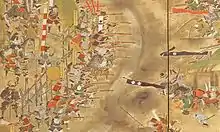
In 1575, Takeda Katsuyori, son of Takeda Shingen, attacked Nagashino Castle when Okudaira Sadamasa rejoined the Tokugawa and his original plot with Oga Yashiro to take Okazaki Castle, the capital of Mikawa, was discovered.[16]:80–82 Ieyasu appealed to Nobunaga for help and Nobunaga personally lead an army of about 30,000 men. The combined force of 38,000 men under Nobunaga and Tokugawa Ieyasu defeated and devastated the Takeda clan with the strategic use of arquebuses at the decisive battle in Nagashino. Nobunaga compensated for the arquebus' slow reloading time by organizing the arquebusiers in three rows, firing in rotation. Takeda Katsuyori also wrongly assumed that rain had ruined the gunpowder of Nobunaga's forces.[17]
From there, Nobunaga continued his expansion, sending Akechi Mitsuhide to pacify Tanba Province and Hashiba Hideyoshi to Himeji Castle, before advancing upon the Mori clan in Nagato Province.[4]:287,306 The end of the Takeda clan came in 1582, when Oda-Tokugawa forces conquered Kai Province. Takeda Katsuyori was defeated at the Battle of Tenmokuzan and then committed seppuku.
Conflict with Uesugi
The Tedorigawa Campaign was precipitated by Uesugi intervention in the domain of the Hatakeyama clan in Noto Province, an Oda client state. This event provoked the Uesugi incursion, a coup d'état led by the pro-Oda General Chō Shigetsura, who killed Hatakeyama Yoshinori, the lord of Noto and replaced him with Hatakeyama Yoshitaka as a puppet ruler. As a result, Uesugi Kenshin, the head of the Uesugi clan, mobilized an army and led it into Noto against Shigetsura. Consequently, Nobunaga sent an army led by Shibata Katsuie and some of his most experienced generals to attack Kenshin. They clashed at the Battle of Tedorigawa in Kaga Province in November 1577. The result was a decisive Uesugi victory, and Nobunaga considered ceding the northern provinces to Kenshin, but Kenshin's sudden death in early 1578 caused a succession crisis that ended the Uesugi's movement to the south.[3]:12–13,228,230[4]:288
Tenshō Iga War
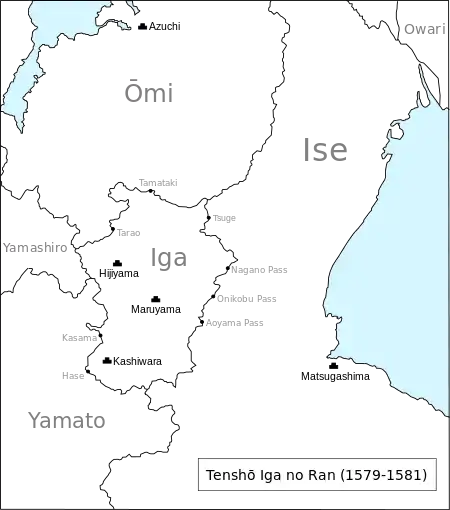
Tenshō Iga War (天正伊賀の乱, Tenshō Iga no Ran) were two invasions of Iga province by the Oda clan during the Sengoku period. The province was conquered by Oda Nobunaga in 1581 after an unsuccessful attempt in 1579 by his son Oda Nobukatsu. The names of the wars are derived from the Tenshō era name (1573–92) in which they occurred. Other names for the campaign include "The Attack on Iga" (伊賀攻め, Iga-zeme) or "Pacification of Iga" (伊賀平定, Iga Heitei). Oda Nobunaga himself toured the conquered province in early November 1581, and then withdrew his troops, placing control in Nobukatsu's hands.
Death
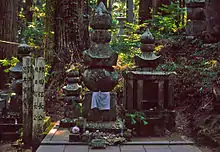
By 1582, Nobunaga was at the height of his power and, as the most powerful warlord, the de facto leader of Japan. Nobunaga and Ieyasu finally defeated the Takeda at the Battle of Tenmokuzan, destroying the clan and resulting in Takeda Katsuyori fleeing from the battle before committing suicide with his wife while being pursued by Oda forces.[3] By this point, Nobunaga was preparing to launch invasions into Echigo Province and Shikoku. Nobunaga's former sandal bearer, Hashiba Hideyoshi, invaded Bitchū Province and laid siege to Takamatsu Castle. The castle was vital to the Mori clan, and losing it would have left the Mori's home domain vulnerable. Mori reinforcements led by Mōri Terumoto arrived to relieve the siege, prompting Hideyoshi to ask for reinforcements from Nobunaga, who promptly ordered his leading generals to prepare their armies, with the overall expedition to be led by Nobunaga.[9]:241[4]:307a Nobunaga left Azuchi Castle for Honnō-ji, a temple in Kyoto he frequented when visiting the city, where he was to hold a tea ceremony. Hence, Nobunaga only had 30 pages with him, while his son Oda Nobutada had brought 2000 of his cavalrymen.[9]:243
Akechi Mitsuhide, stationed in the Chūgoku region, decided to assassinate Nobunaga for unknown reasons, and the cause of his betrayal is controversial. Mitsuhide, aware that Nobunaga was nearby and unprotected for his tea ceremony, saw an opportunity to act. Mitsuhide led his army toward Kyoto under the pretense of following the order of Nobunaga, but as they were crossing Katsura River, Mitsuhide announced to his troops that "The enemy awaits at Honnō-ji!" (敵は本能寺にあり, Teki wa Honnō-ji ni ari). On 21 June 1582, before dawn, the Akechi army surrounded the Honnō-ji temple with Nobunaga present, while another unit of Akechi troops were sent to Myōkaku-ji in a coup. Although Nobunaga and his servants resisted the unexpected intrusion, they were soon overwhelmed. As the Akechi troops closed in, Nobunaga decided to commit seppuku in one of the inner rooms. Reportedly his last words were, "Ran, don't let them come in..." referring to his young page, Mori Ranmaru, who set the temple on fire as Nobunaga requested so that no one would be able to get his decapitated head. Ranmaru then followed his lord, with his loyalty and devotion making him a revered figure in Japanese history. Nobunaga's remains were never found, a fact often speculated about by writers and historians. After capturing Honnō-ji, Mitsuhide attacked Nobutada, eldest son and heir of Nobunaga, who also committed suicide.[4]:307–8
Nobunaga was succeeded by his retainer Toyotomi Hideyoshi, who subsequently abandoned his campaign against the Mōri clan to pursue Mitsuhide to avenge his beloved lord. Hideyoshi's intercepted one of Mitsuhide's messengers trying to deliver a letter to the Mōri requesting to form an alliance against the Oda after informing them of Nobunaga's death. Hideyoshi managed to pacify the Mōri by demanding the suicide of Shimizu Muneharu in exchange for ending his siege of Takamatsu Castle, which the Mōri accepted. Mitsuhide failed to establish his position after Nobunaga's death and Hideyoshi defeated his army at the Battle of Yamazaki in July, but Mitsuhide was murdered by bandits while fleeing after the battle. Hideyoshi continued and completed Nobunaga's conquest of Japan within the following decade.
Historical context

The goal of national unification and a return to the comparative political stability of the earlier Muromachi period was widely shared by the multitude of autonomous daimyōs during the Sengoku period. Oda Nobunaga was the first for whom this goal seemed attainable. Nobunaga had gained control over most of Honshu (see map below) before his death during the 1582 Honnō-ji incident, a coup attempt executed by Nobunaga's vassal, Akechi Mitsuhide. Nobunaga was betrayed by his own retainers who set the Honno-Ji temple on fire; then, instead of burning in flames, Oda Nobunaga had committed seppuku to escape the flames. The motivation behind Mitsuhide's betrayal was never revealed to anyone who survived the incident, and has been a subject of debate and conjecture ever since the incident.[18]
Following the incident, Mitsuhide declared himself master over Nobunaga's domains, but was quickly defeated by Toyotomi Hideyoshi, who regained control of and greatly expanded the Oda holdings. Nobunaga's successful subjugation of much of Honshu enabled the later successes of his allies Hideyoshi and Tokugawa Ieyasu toward the goal of national unification by subjugating local daimyōs under a hereditary shogunate, which was ultimately accomplished in 1603 when Ieyasu was granted the title of shōgun by Emperor Go-Yōzei following the successful Sekigahara Campaign of 1600. The nature of the succession of power through the three daimyōs is reflected in a well-known Japanese idiom:
Nobunaga pounds the national rice cake, Hideyoshi kneads it, and in the end, Ieyasu sits down and eats it.[19]
The changing character of power through Nobunaga, Hideyoshi and Ieyasu is reflected in a well known idiom:
Nobunaga said: "Little bird, sing. If you don't sing, I will kill you".
Hideyoshi said: "Little bird, sing. If you don't sing, I will make you sing".
Ieyasu said: "Little bird, sing. If you don't sing, I will wait for you sing".
All three were born within eight years of each other (1534 to 1542), started their careers as samurai and finished them as statesmen. Nobunaga inherited his father's domain at the age of 17, and quickly gained control of Owari province through gekokujo. Hideyoshi started his career in Nobunaga's army as an ashigaru, but quickly rose up through the ranks as a samurai. Ieyasu initially fought against Nobunaga as the heir of a rival daimyo, but later expanded his own inheritance through a profitable alliance with Nobunaga.[10]:142
Influence

Military
Militarily, Nobunaga changed the way war was fought in Japan. His matchlock gunners and tanegashima armed foot soldiers, displaced mounted soldiers armed with bow and sword. He built iron-plated warships and imported saltpeter and lead for manufacturing gunpowder and bullets respectively, while also manufacturing artillery. His ashigaru foot soldiers were trained and disciplined for group and mass movements, which replaced hand-to-hand fighting tactics. They wore distinctive uniforms which fostered esprit de corps, red troops and black troops. He was ruthless and cruel in battle, pursuing fugitives without compassion. Through wanton slaughter, he became the ruler of 20 provinces.[4]:309–10
Policies
After consolidating military power in provinces he came to dominate, starting with Owari and Mino, Nobunaga implemented a plan for economic development. This included the declaration of free markets (rakuichi), the breaking of trade monopolies, and providing for open guilds (rakuza). Nobunaga instituted rakuichi rakuza (楽市楽座) policies as a way to stimulate business and the overall economy through the use of a free market system.[12] These policies abolished and prohibited monopolies and opened once closed and privileged unions, associations and guilds, which he saw as impediments to commerce. Even though these policies provided a major boost to the economy, it was still heavily dependent on daimyōs' support. Copies of his original proclamations can be found in Entoku-ji in the city of Gifu.[12][4]:300
Nobunaga initiated policies for civil administration, which included currency regulations, construction of roads and bridges. This included setting standards for the road widths and planting trees along roadsides. This was to ease the transport of soldiers and war material in addition to commerce. In general, Nobunaga thought in terms of "unifying factors," in the words of George Sansom.[4]:300–2
Culture
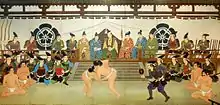
Nobunaga initiated a period in Japanese art history known as Fushimi, or the Azuchi-Momoyama period, in reference to the area south of Kyoto. He built extensive gardens and castles which were themselves great works of art. Azuchi Castle included a seven-story Tenshukaku, which included a treasury filled with gold and precious objects. Works of art included paintings on movable screens (byōbu), sliding doors (fusuma), and walls by Kanō Eitoku. During this time, Nobunaga's tea master Sen no Rikyū established key elements of the Japanese tea ceremony.[4]:380–82 Nobunaga was also famous for his meibutsu-gari hunt-down and acquisition of famous objects by which he collected tea ceremony objects with famous poetic or historic lineages.
Additionally, Nobunaga was very interested in European culture which was still very new to Japan. He collected pieces of Western art as well as arms and armor, and he is considered to be among the first Japanese people in recorded history to wear European clothes. He also became the patron of the Jesuit missionaries in Japan and supported the establishment of the first Christian church in Kyoto in 1576,[20] although he never converted to Christianity.[21]
Family

Depending upon the source, Oda Nobunaga and the entire Oda clan are descendants of either the Fujiwara clan or the Taira clan (specifically, Taira no Shigemori's branch). His lineage can be directly traced to his great-great-grandfather, Oda Hisanaga, who was followed by Oda Toshisada, Oda Nobusada, Oda Nobuhide, and Nobunaga himself.
Immediate family
Nobunaga was the eldest legitimate son of Nobuhide, a minor warlord from Owari Province, and Tsuchida Gozen, who was also the mother to three of his brothers (Nobuyuki, Nobukane, and Hidetaka) and two of his sisters (Oinu and Oichi).
- Father: Oda Nobuhide (1510–1551)
- Mother: Tsuchida Gozen (died 1594)
- Brothers
- Oda Nobuhiro (died 1574)
- Oda Nobuyuki (1536–1557)
- Oda Nobukane (1548–1614)
- Oda Nagamasu (1548–1622)
- Oda Nobuharu (1549–1570)
- Oda Nobutoki (died 1556)
- Oda Nobuoki
- Oda Hidetaka (died 1555)
- Oda Hidenari
- Oda Nobuteru
- Oda Nagatoshi
- Sisters:
- Oichi (1547–1583)
- Oinu, married Saji Nobukata later married Hosokawa Nobuyoshi
Descendants
Nobunaga married Nōhime, the daughter of Saitō Dōsan, as a matter of political strategy; however, she was unable to give birth to children and was considered to be barren. It was his concubines Kitsuno and Lady Saka who bore his children. Kitsuno gave birth to Nobunaga's eldest son, Nobutada. Nobutada's son Hidenobu became ruler of the Oda clan after the deaths of Nobunaga and Nobutada. His son Oda Nobuhide was a Christian, and took the baptismal name Peter; he was adopted by Toyotomi Hideyoshi and commissioned chamberlain.
- Sons
- Oda Nobutada (1557–1582)
- Oda Nobukatsu (1558–1630)
- Oda Nobutaka (1558–1583)
- Hashiba Hidekatsu (1567–1585)
- Oda Katsunaga (died 1582)
- Oda Nobuhide (1571–1597)
- Oda Nobutaka later Toyotomi Takajuro (1576–1602) adopted by Toyotomi Hideyoshi
- Oda Nobuyoshi later Toyotomi Musashimori (1573–1615) adopted by Toyotomi Hideyoshi
- Oda Nobusada (1574–1624)
- Oda Nobuyoshi (died 1609) adopted by Toyotomi Hideyoshi
- Oda Nagatsugu (died 1600)
- Oda Nobumasa (1554–1647, illegitimate child)
- Daughters
- Tokuhime (1559–1636), married Matsudaira Nobuyasu
- Fuyuhime (1561–1641), married Gamō Ujisato
- Hideko (died 1632), married Tsutsui Sadatsugu
- Eihime (1574–1623), married Maeda Toshinaga
- Hōonin, married Niwa Nagashige
- Sannomarudono (died 1603), concubine to Toyotomi Hideyoshi, married Nijō Akizane
- Tsuruhime, married Nakagawa Hidemasa
- Oushin, concubine of Saji Kazunari
- Ofuri, married Mizune Tadatane
- Marikoji Mitsufusa's wife
- Tokudaiji Sanehisa's wife
- Adopted:
- Toyama Fujin married Takeda Katsuyori
- Ashikaga Yoshiaki
Other relatives
One of Nobunaga's younger sisters, Oichi, gave birth to three daughters. These three nieces of Nobunaga became involved with important historical figures. Chacha (also known as Lady Yodo), the eldest, became the mistress of Toyotomi Hideyoshi. O-Hatsu married Kyōgoku Takatsugu. The youngest, O-go, married the son of Tokugawa Ieyasu, Tokugawa Hidetada (the second shōgun of the Tokugawa shogunate). O-go's daughter Senhime married her cousin Toyotomi Hideyori, Lady Yodo's son.
Nobunaga's nephew was Tsuda Nobuzumi, the son of Nobuyuki. Nobusumi married Akechi Mitsuhide's daughter and was killed after the Honnō-ji coup by Nobunaga's third son, Nobutaka, who suspected him of being involved in the plot.
Later descendants
Nobunaga's granddaughter Oyu no Kata, by his son Oda Nobuyoshi, married Tokugawa Tadanaga.
Nobunari Oda, a retired figure skater, claims to be a 17th generation direct descendant of Nobunaga.[22][23] The ex-monk celebrity Mudō Oda also claims descent from the Sengoku period warlord, but his claims have not been verified.
Honors
- Imperial Court, Senior First Rank (November 17, 1917; posthumous)
The Tutors of young Nobunaga
- Hayashi Hidesada (林 秀貞, ? – November 21, 1580). He was also known as Michikatsu (通勝). His court title was Sado no Kami.
- Hirate Masahide (平手 政秀, 1492 – February 25, 1553). Served the Oda clan for two generations. His original name was Hirate Kiyohide (平手 清秀).
Dōjigiri sword
One of the Five Swords under Heaven (天下五剣) Made by Hōki Yasutsuna, legendary sword with which Minamoto no Yorimitsu killed the boy-faced oni Shuten-dōji (酒呑童子) living near Mount Oe. Presented to Oda Nobunaga by the Ashikaga family subsequently in possession of Toyotomi Hideyoshi and Tokugawa Ieyasu.
In popular culture
Nobunaga appears frequently within fiction and continues to be portrayed in many different anime, manga, video games, and cinematic films. Many depictions show him as villainous or even demonic in nature, though some portray him in a more positive light. The latter type of works include Akira Kurosawa's film Kagemusha, which portrays Nobunaga as energetic, athletic and respectful towards his enemies. The film Goemon portrays him as a saintly mentor of Ishikawa Goemon. Nobunaga is a central character in Eiji Yoshikawa's historical novel Taiko Ki, where he is a firm but benevolent lord. Nobunaga is also portrayed in a heroic light in some video games such as Kessen III, Ninja Gaiden II, and the Warriors Orochi series. While in the anime series "Nobunaga no Shinobi" Nobunaga is portrayed as a kind person as well as having a major sweet tooth.
By contrast, in the novel The Samurai's Tale by Erik Christian Haugaard, he is portrayed as an antagonist "known for his merciless cruelty".[24] He is portrayed as evil or megalomaniacal in some anime and manga series including Samurai Deeper Kyo and Flame of Recca. Nobunaga is portrayed as evil, villainous, bloodthirsty, and/or demonic in many video games, such as the Onimusha series, Ninja Master's, Sengoku, Maplestory, Inindo: Way of the Ninja, Atlantica Online, the Samurai Warriors series, the Sengoku BASARA series (and its anime adaptation), and the Soulcalibur series.
Nobunaga has been portrayed numerous times in a more neutral or historic framework, especially in the Taiga dramas shown on television in Japan. Oda Nobunaga appears in the manga series Tail of the Moon, Kacchū no Senshi Gamu, and Tsuji Kunio's historical fiction The Signore: Shogun of the Warring States. Historical representations in video games (mostly Western-made strategy or action titles) include Shogun: Total War, Total War: Shogun 2, Throne of Darkness, the eponymous Nobunaga's Ambition series, as well as Civilization V,[25] Age of Empires II: The Conquerors, Nioh, and Nioh 2. Kamenashi Kazuya of the Japanese pop group KAT-TUN wrote and performed a song titled "1582" which is written from the perspective of Mori Ranmaru during the coup at Honnō temple.[26]
Nobunaga has also been portrayed fictively, such as when the figure of Nobunaga influences a story or inspires a characterization. In James Clavell's novel Shōgun, the character Goroda is a pastiche of Nobunaga. In the film Sengoku Jieitai 1549, Nobunaga is killed by time-travellers. The novel and anime series Yōtōden, the novel The Ouka Ninja Scrolls: Basilisk New Chapter and the anime and manga Basilisk portray Nobunaga as a literal demon in addition to a power-mad warlord. Nobunaga also appears as a major character in the eroge Sengoku Rance and is a playable character in Pokémon Conquest, with his partner Pokémon being Hydreigon, Rayquaza and Zekrom.[27] Nobunaga is depicted as a female character in the anime Sengoku Otome: Momoiro Paradox, Sengoku Collection, the video game Fate/Grand Order, and in the light novel and anime series The Ambition of Oda Nobuna. He is the main character of the stage action and anime adaptation of Nobunaga the Fool. In Kouta Hirano's Drifters, Nobunaga is rescued before the moment of his death and is sent to another world to fight against other historical figures. Therein, he displays equal parts tactical brilliance and gleeful brutality. In the 2014 anime Nobunaga Concerto, and its 2015 film adaptation, he is the subject of a complex plot involving time travel and alternate history.
References
- Jansen, Marius (2000). The Making of Modern Japan, p. 11.
- Okanoya, Shigezane (2007) [based on 1943 edition by Iwanami Shoten, Japan; first edition 1871]. "Tale 3 – His Extraordinary Appearance". In Dykstra, Andrew; Dykstra, Yoshiko (eds.). Meishōgenkōroku [Shogun and Samurai – Tales of Nobunaga, Hideyoshi, and Ieyasu] (PDF). translated by Andrew and Yoshiko Dykstra. Retrieved 2010-07-21.
- Turnbull, Stephen (1998). The Samurai Sourcebook. Cassell & Co. p. 215. ISBN 978-1-85409523-7.
- Sansom, George (1961). A History of Japan, 1334–1615. Stanford University Press. p. 276. ISBN 978-0-80470525-7.
- Takeuchi, Rizō (1985). Nihonshi shōjiten, p. 233.
- Turnbull, Stephen (1987). Battles of the Samurai. Arms and Armour Press. p. 37. ISBN 978-0-85368826-6.
- Weston, Mark. "Oda Nobunaga: The Warrior Who United Half of Japan". Giants of Japan: The Lives of Japan's Greatest Men and Women. New York: Kodansha International, 2002. 140–145. Print.
- Seal, F. W. "Oda Nobunaga".
- Sato, Hiroaki (1995). Legends of the Samurai. Overlook Duckworth. pp. 234–37. ISBN 978-1-59020730-7.
- Turnbull, Stephen R. (1977). The Samurai: A Military History. New York: MacMillan Publishing Co. p. 144.
- Gifu Castle Archived 2007-12-21 at the Wayback Machine. Oumi-castle.net. Retrieved December 5, 2007.
- Gifu City Walking Map. Gifu Lively City Public Corporation, 2007.
- Saito, Hisho. A History of Japan. p. 130. ISBN 978-1-44004213-3.
- Winkler, Lawrence (2016-08-03). Samurai Road. Bellatrix. ISBN 978-0-99169418-1.
- Wakita Osamu (1982), "The Emergence of the State in Sixteenth-Century Japan: From Oda to Tokugawa", The Journal of Japanese Studies, 8 (2): 343–67, doi:10.2307/132343, JSTOR 132343
- Turnbull, Stephen (1987). Battles of the Samurai. London: Arms and Armour Press. pp. 79–94. ISBN 978-0-85368826-6.
- Lyons, Chuck (2017). "What we learned from... Nagashino, 1575". Military History. 34: 18 – via EBSCOHost.
- Berry, Mary Elizabeth (1982). Hideyoshi. Cambridge and London: The Council on East Asian Studies, Harvard University. pp. 41–43. ISBN 978-0-674-39026-3.
- Duiker, William J.; Spielvogel, Jackson J. (2006), World History, II, Cengage Learning, pp. 463, 474, ISBN 978-0-495-05054-4, attributed to C. Nakane and S. Oishi 1990 eds., Tokugawa Japan Tokyo, p. 14. Hashiba is the family name that Toyotomi Hideyoshi used while he was a follower of Nobunaga. In Japanese: "織田がつき 羽柴がこねし 天下餅 座りしままに 食うは徳川". Variants exist.
- Shunkoin Temple in Kyoto, JAPAN Archived 2007-10-21 at the Wayback Machine Shunkoin Temple Organization. Retrieved September 19, 2007.
- Mark Weston 1999, Giants of Japan: the lives of Japan's greatest men and women, New York: Kodansha International, 142.
- Crystal Report Viewer. International Skating Union. Retrieved on 2007-08-19 from "Isufs". Archived from the original on 2005-10-16. Retrieved 2011-11-10.
- Smile Wind. Nobunari Oda. Retrieved on 2007-09-15 from "Archived copy". Archived from the original on 2006-04-20. Retrieved 2006-03-27.CS1 maint: archived copy as title (link)
- Erik Christian Haugaard (1984). The Samurai's Tale. Houghton Mifflin Books. p. ix.
Lord Oda Nobunaga – Lord Takeda Shingen's rival and enemy, well known for his merciless cruelty
- "Civilization® VI – the Official Site".
- "English Translation and Backstory of the song 1582". Kattun-hyphens.com. Archived from the original on 2012-04-26. Retrieved 2014-05-22.
- "Nobunaga + Zekrom – Pokémon Conquest characters". Pokémon. Retrieved 2012-06-17.
Bibliography
- Hall, John Whitney, ed. The Cambridge History of Japan, Vol. 4: Early Modern Japan (1991) table of contents
- Jansen, Marius B. (2000). The Making of Modern Japan. Cambridge: Harvard University Press. ISBN 9780674003347, OCLC 44090600
- Perkins, Dorothy Encyclopedia of Japan. New York, Roundtable Press, 1991
- Eisenstadt S. N. Japanese Civilization London, University of Chicago Press, 1996
- Morton W. Scott & Olenik J. Kenneth, Japan, Its History and Culture (4th edition). United States, McGraw-Hill company, 1995
External links
| Wikiquote has quotations related to: Oda Nobunaga |
| Wikimedia Commons has media related to Oda Nobunaga. |
- OdaNobunaga.com, a history website dedicated to Oda Nobunaga
- Oda Nobunaga at the Samurai Archive
- The Christian Century in Japan, by Charles Boxer
